Travel Log, Panama
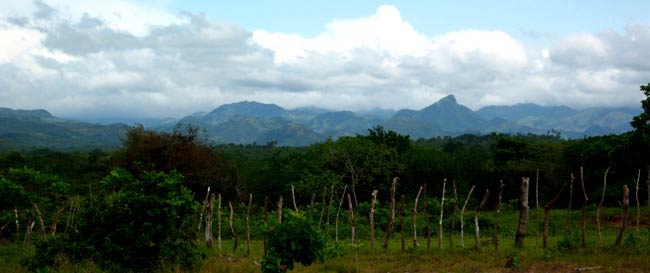
The story starts at the border ....
We awoke early to make the border before the rush, a fortunate choice as we had a flat, our second in two days. Turned out to be a valve stem extension chaffed by the wheel cover. We've learned to get help for our flat tires so about half an hour later and a couple of dollars poorer, we were on our way again, determined to try a different valve extension system.
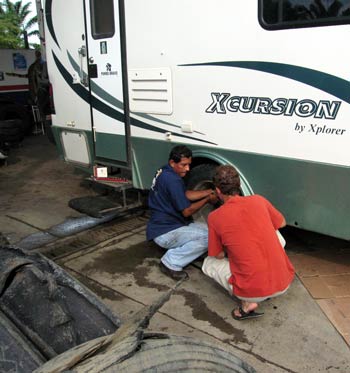 It was only 18 more kilometers down the Pan American highway to the border town of Paso Canoas. We arrived around 9:30 AM and breezed through migracion and aduana to leave Costa Rica. Then we tried to find a place to park the rig to do the Panama entry. Driving down a crowded side road a piece of heavy gauge wire punctured the same tire we'd just fixed!!! As we got out to inspect the noise it made, a number of Panamanian men instantly gathered around, giving us advice. One eager guy grabbed the wire to pull it out. Kathleen yelled "NO!", while Rus got the vice grips, then yanked it out and measured the depth of the puncture. A little over a centimeter, we decided to wait and see. It turned out the tire was fine but we were not in the best mood for another Central American border crossing. It was only 18 more kilometers down the Pan American highway to the border town of Paso Canoas. We arrived around 9:30 AM and breezed through migracion and aduana to leave Costa Rica. Then we tried to find a place to park the rig to do the Panama entry. Driving down a crowded side road a piece of heavy gauge wire punctured the same tire we'd just fixed!!! As we got out to inspect the noise it made, a number of Panamanian men instantly gathered around, giving us advice. One eager guy grabbed the wire to pull it out. Kathleen yelled "NO!", while Rus got the vice grips, then yanked it out and measured the depth of the puncture. A little over a centimeter, we decided to wait and see. It turned out the tire was fine but we were not in the best mood for another Central American border crossing.
Similar to the other countries each step of the entry procedure was done in a different place, without a sign to guide you, and here a few extra steps were thrown in for good measure. Being Saturday it was worse, some offices were "closed". Kathleen hired a transito. Rus was mad at her for breaking our nearly perfect run of independent border crossings, but if it hadn't been for Jovel, we might be there still!
The Agricultura offices on both sides were closed, but we needed to get Ziggy's papers stamped out of Costa Rica and into Panama. Now why, if an office is "closed", are there officials sitting inside with the door open and the lights on, telling you they're closed? It's another of those things that makes gringos bang their heads. But it doesn't bother us so much any more, we just find out what it takes to make the office "open". On the Costa Rica side, it was having Jovel, our transito, as the intermediary. On the Panama side, it was a $20 bribe to the reptile-eyed, paunchy official, down from an opening bid of $40. Ziggy now has more stamps on her U.S.D.A. papers than we have on our passports.
 Finally out the other side, stamped, permitted and sprayed for bugs for a fee, of course, we edged out onto a modern 4-lane divided highway, just begging you to accelerate, and lots of police hoping you do. We were stopped about 4 times in the first 20 miles for document checks and one mordida request. The officer explained that he'd received a radio call from the previous checkpoint that we'd been speeding but they were too busy to stop us, so he was supposed to collect the multa, or fine. It was a creative approach, but we weren't going for it, as we'd exchanged a pleasant bit of conversation with the officer at the last post. He realized it too after a few minutes, and wished us happy travels. Finally out the other side, stamped, permitted and sprayed for bugs for a fee, of course, we edged out onto a modern 4-lane divided highway, just begging you to accelerate, and lots of police hoping you do. We were stopped about 4 times in the first 20 miles for document checks and one mordida request. The officer explained that he'd received a radio call from the previous checkpoint that we'd been speeding but they were too busy to stop us, so he was supposed to collect the multa, or fine. It was a creative approach, but we weren't going for it, as we'd exchanged a pleasant bit of conversation with the officer at the last post. He realized it too after a few minutes, and wished us happy travels.
Panama is green, very green, at least this time of year (early August). The north is sparsely populated, except for the sizable town of David, and we were in a good groove driving, enjoying the spectacular scenery as the miles rolled by. The local indigenous women in their traditional dress sell beaded necklaces and embroidered clothes from roadside huts. We didn't stop but their presence added interest and color to the natural beauty we were soaking in around every bend. Our destination was Santa Clara, and we were going to make it before dark.
XS Memories RV Park and Panama City
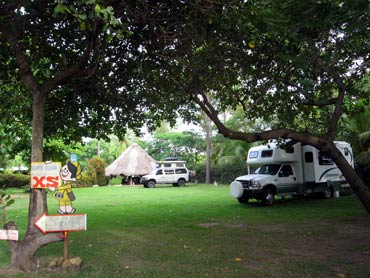 Panama City is the last stop before you either turn around and head back to the U.S., or continue by ship to a South American port. There are enough people doing both to support a very nice campground in Santa Clara, about an hour north of Panama City, called XS Memories, owned by expatriates Dennis and Sheila. The XS has shaded sites with all utilities, coconut palms, mango trees, a pool, restaurant, monkeys and a scarlet macaw. Oh, and wireless internet. When we drove in there was one other vehicle, a totally cool tricked-out 4x4 Sportsmobile camper van, built like a rolling boat. One of its occupants called out to us, "Are you Rus and Kathleen?" Photo above: XS Memories RV Park and the palapa with wifi, which became our 'office'. Panama City is the last stop before you either turn around and head back to the U.S., or continue by ship to a South American port. There are enough people doing both to support a very nice campground in Santa Clara, about an hour north of Panama City, called XS Memories, owned by expatriates Dennis and Sheila. The XS has shaded sites with all utilities, coconut palms, mango trees, a pool, restaurant, monkeys and a scarlet macaw. Oh, and wireless internet. When we drove in there was one other vehicle, a totally cool tricked-out 4x4 Sportsmobile camper van, built like a rolling boat. One of its occupants called out to us, "Are you Rus and Kathleen?" Photo above: XS Memories RV Park and the palapa with wifi, which became our 'office'.
It was Arelis, of Neil and Arelis, also traveling to South America, who our friends Mark and Liesbet met in Guatemala and emailed us about. They joined us for a beer and we talked for hours. They are both American citizens, though Neil is originally British and Arelis originally Dominican. They're 8 months into a journey around the world, taking it one day at a time (their website is: www.landhopping.com). They'd arrived three days before, and were there investigating options for shipping their rig to either Columbia or Ecuador.
 Here's an important travel tip: you can't drive to South America. There's a stretch of land between Panama and Columbia called the Darien Gap, and a border neither country patrols. We've heard unconfirmed stories of a very few extreme 4-wheel-drive vehicles and their equally extreme drivers making it through the steamy lowland jungle, infested with malaria mosquitoes, guerillas and bandits, but the Darien region is generally regarded as impassible, except (and not recommended) by hiring Indians to guide you on a 7-8-day journey by boat and on foot, across the 70-mile stretch. Photo: Neil and Arelis in our 'office' at XS Memories Here's an important travel tip: you can't drive to South America. There's a stretch of land between Panama and Columbia called the Darien Gap, and a border neither country patrols. We've heard unconfirmed stories of a very few extreme 4-wheel-drive vehicles and their equally extreme drivers making it through the steamy lowland jungle, infested with malaria mosquitoes, guerillas and bandits, but the Darien region is generally regarded as impassible, except (and not recommended) by hiring Indians to guide you on a 7-8-day journey by boat and on foot, across the 70-mile stretch. Photo: Neil and Arelis in our 'office' at XS Memories
Neil and Arelis had an appointment to see a shipping agent in Panama City, and invited us to join them. The four of us were mulling over the idea of shipping to Columbia and driving through the country together for an added measure of security. Their van just barely fits into a shipping container, which gives them more options, but because of our size our choices were RO/RO (roll on/roll off, where vehicles are driven on and off) or LO/LO (load on/load off, where the vehicle is driven onto a platform, secured, then craned aboard). The agent we met with, Heidi Kam, (e-mail: hkam@gakam.com) was knowledgeable and very helpful. She found us a RO/RO ship to Cartagena, Columbia, one to Callao, Peru, one to Puerto Cabello, Venezuela, and still another to Arica, Chile. For our rig, the prices ranged from $3495 to $3850, and for their rig, about $2000 less. The price is calculated by cubic meters for RO/RO or LO/LO.
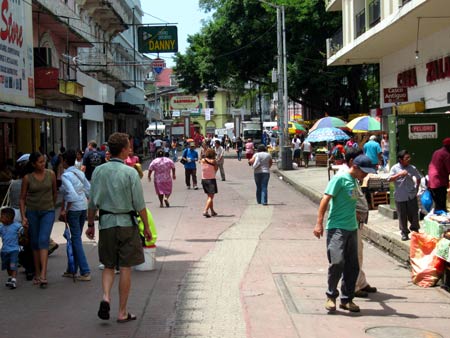 But we were having second thoughts. Since we were returning to California in September for our son's wedding, this was the scenario: after shipping our rig from Panama, we'd fly to the destination port up to two weeks later to get it off the ship and through customs. Then we'd continue on until it was time to fly to California, and find a safe place to store the rig with all our possessions inside and the moto outside, for 2-3 weeks while we were gone. Then a long flight to San Francisco or LA, a long drive in a rental car, and no home while we're there. Then we'd fly back to South America, praying our rig hadn't been ransacked in our absence. And all this with our Labrador, Ziggy, who goes wherever we go. From the experiences of other travelers, we know there are often long delays getting a ship, up to a month. Sometimes the one you've booked can't accommodate your rig after all, and you're back to square one. We've heard of ships not stopping at your port because of a sudden change of route, and we've heard of others arriving and leaving port a day earlier than scheduled, and people missing the ship they'd waited weeks for. Then there are the unanticipated customs hassles on the other end, adding delays, expense and aggravation. But we were having second thoughts. Since we were returning to California in September for our son's wedding, this was the scenario: after shipping our rig from Panama, we'd fly to the destination port up to two weeks later to get it off the ship and through customs. Then we'd continue on until it was time to fly to California, and find a safe place to store the rig with all our possessions inside and the moto outside, for 2-3 weeks while we were gone. Then a long flight to San Francisco or LA, a long drive in a rental car, and no home while we're there. Then we'd fly back to South America, praying our rig hadn't been ransacked in our absence. And all this with our Labrador, Ziggy, who goes wherever we go. From the experiences of other travelers, we know there are often long delays getting a ship, up to a month. Sometimes the one you've booked can't accommodate your rig after all, and you're back to square one. We've heard of ships not stopping at your port because of a sudden change of route, and we've heard of others arriving and leaving port a day earlier than scheduled, and people missing the ship they'd waited weeks for. Then there are the unanticipated customs hassles on the other end, adding delays, expense and aggravation.
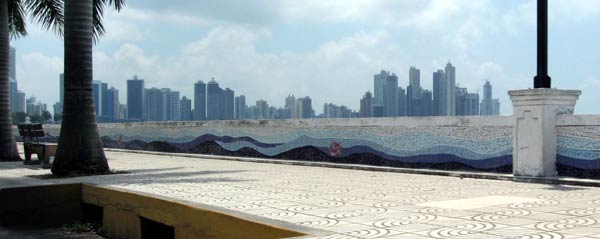
Panama City Skyline
Even though it's over 5,000 miles from Panama City to our home town in Northern California, the crazy idea of driving back instead was starting to look pretty good. We'd be avoiding a couple of flights and the possibility of our rig being ransacked while we were gone, plus we'd have a vehicle and a place to stay in California (we've rented our own house out until next June). Not to mention the opportunity to make some needed repairs to the coach and have the truck serviced. But most of all, it seemed like more fun, as long as we didn't rush the trip. We made the decision to drive back to California IF we could find a ship from a U.S. port to South America. So from our comfortable camp, we set up an office under the palapa next to the pool and immersed ourselves in the world of RO/RO and LO/LO, emailing and Skyping shipping agents in the States.
From the U.S. to South America the ships are fewer. There's another wrinkle: the vehicle is transferred to another ship in Panama, and may sit in a yard there for up to two weeks between ships. But in a day or so, we found several RO/RO agents, contacted them, and were able to get quotes from two: from Houston to Chile, $6995, estimated transit 4 weeks; and from Long Beach to Venezuela, $953.87, transit time 2-3 weeks. Gosh, which one would you choose?
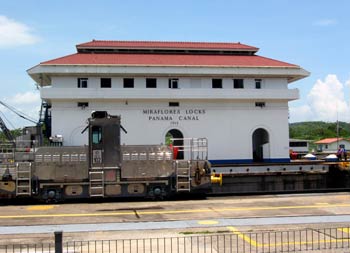 We called to jump on Long Beach, but found that U.S. Customs there requires vehicles to be completely unlocked and empty during transit, not just the cab but the coach as well, and all the storage bins. That means our rig would be sitting unlocked for up to a month, some of that time in ports such as Panama's. For Kathleen, that nixed it; but Rus was adding up all the stuff we could replace for a lot less than the $6000 price difference. We figured we could find other options as well once we were in the States with good phone service and our excellent English, so we made the decision to drive back, taking a month for the trip (which seemed a break-neck pace, given the 5 months it took to get this far!). We were looking forward to seeing places we'd missed coming down, and revisiting some we loved. We called to jump on Long Beach, but found that U.S. Customs there requires vehicles to be completely unlocked and empty during transit, not just the cab but the coach as well, and all the storage bins. That means our rig would be sitting unlocked for up to a month, some of that time in ports such as Panama's. For Kathleen, that nixed it; but Rus was adding up all the stuff we could replace for a lot less than the $6000 price difference. We figured we could find other options as well once we were in the States with good phone service and our excellent English, so we made the decision to drive back, taking a month for the trip (which seemed a break-neck pace, given the 5 months it took to get this far!). We were looking forward to seeing places we'd missed coming down, and revisiting some we loved.
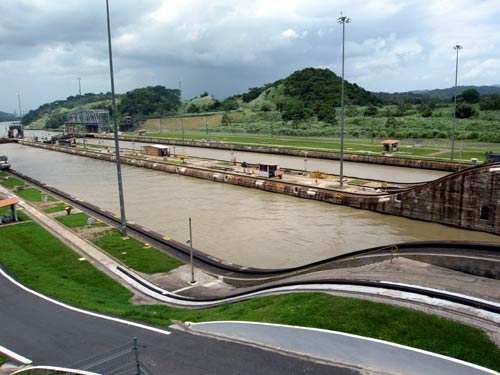 Before leaving, we made a couple of trips into Panama City on local buses with Neil and Arelis. Of course, we had to see the Panama Canal. Watching ships coming through the Miraflores Locks is a sight you can't quite believe you're really seeing, it's so famous and so far away. And seeing the canal cutting through the Isthmus, and the huge infrastructure devoted to the passage of ships through this place impresses on you the importance of shipping to the world economy. Neil has a book called something like 1001 Places To See Before You Die . We didn't look to see if the Canal was among them, but it ought to be. Before leaving, we made a couple of trips into Panama City on local buses with Neil and Arelis. Of course, we had to see the Panama Canal. Watching ships coming through the Miraflores Locks is a sight you can't quite believe you're really seeing, it's so famous and so far away. And seeing the canal cutting through the Isthmus, and the huge infrastructure devoted to the passage of ships through this place impresses on you the importance of shipping to the world economy. Neil has a book called something like 1001 Places To See Before You Die . We didn't look to see if the Canal was among them, but it ought to be.
The visitors center at Miraflores is a must-see, too. The story of the Canal is fascinating, one of the world's all-time greatest engineering feats. 93 years after their construction, these locks are still dictating the dimensions to which ships are built to transit the Canal. With the importance of the Canal Zone and the huge amount of American investment there, we can only imagine the economic implications of its return to Panama.
Another memorable aspect of our time in Panama was the gorgeous beach at Santa Clara and the pleasant walk there from our camp in the evenings. The sand is white, the water warm and protected for swimming, the palapas and palm trees provide shade and several restaurants offer excellent seafood or a place to have a drink. Camping is permitted, and what a place to camp! (If we didn't want the wifi that would have been our choice). Unfortunately, we have no photos to share it's perfection, we always went there to swim and didn't want to leave the camera on the shore.
(An after note: In November 2006, the people of Panama voted to expand the Canal and build another set of locks to accomodate bigger ships. It's not going to affect us, though, at least not this time!)

Hasta luego!
|



